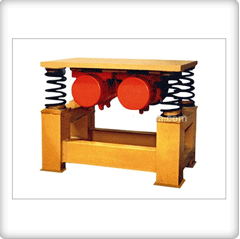MAGWELL offers a wide range of Vibrating tables. Concrete vibration table consists mainly of platform chassis, vibrator spring components, mesa and chassis. They are used for chemical, food, plastics, pharmaceuticals, metallurgy, glass, building materials, food, fertilizers, abrasives, ceramics and other industries.
Principle application of a Vibrating Table is to uniformly fill the mould, drive out air bubble and compact the product to achieve superior mould strength and higher surface finish.

WORKING PRINCIPLE:
Concrete vibration table were welded with steel plate and steel, vibration table is the same motor plus a pair of eccentric composition. And through a pair of pylon coupling installed on mesa (reverse) center position, plays a vibration compaction process smoothly and vertical direction function.
FEATURES:
While using the Vibrating Table you can adjust the vibrating motor’s vibrating force to the platform on the material to achieve the desired form.
- Good sealing performance, no dust overflow
- Continuous production, single or multi-layer, auto-classification filtering
- Energy-saving and low noise with vibration motor
- Start fast and stop smoothly
- Simple installation, easy operation and maintenance
- High power, large platform; maximum power of 7.5kw, exciting force 80KN, sand box can carry the weight of 8T
- Table height adjustable, suitable for assembly line use three-dimensional vibration, complex cavity for casting
- Variable, modeling process, without damage of the premise, for best compaction results
- Since the locking function, the production line to ensure accurate positioning
APPLICATIONS:
It is suitable for any dry material screening from 0.74mm-5mm., the largest particle size is 10mm.It is widely used in chemical, food, plastics, pharmaceuticals, metallurgy, glass, building materials, food, fertilizers, abrasives, ceramics and other industries.
- Food industry: sugar, salt, alkali, gourmet powder, starch, milk powder, yeast powder, pollen, food additive, bean milk, juice, etc.
- Abrasive material and ceramic industry: building sand, mica, alumina, abrasive, refractory material, slurry, etc.
- Chemical industry: resin pigment, medicine, grease, paint, palette, etc.
- Paper-making industry: coated slurry, exhaust liquid, paper making liquid and waste water reclamation, etc.
- Metallurgy and mining industry: quartz sand, ore, titanium oxide, zinc oxide, etc.
- Mechanical industry: casting sand, powder metallurgy, electromagnetic material and metal powder, etc.